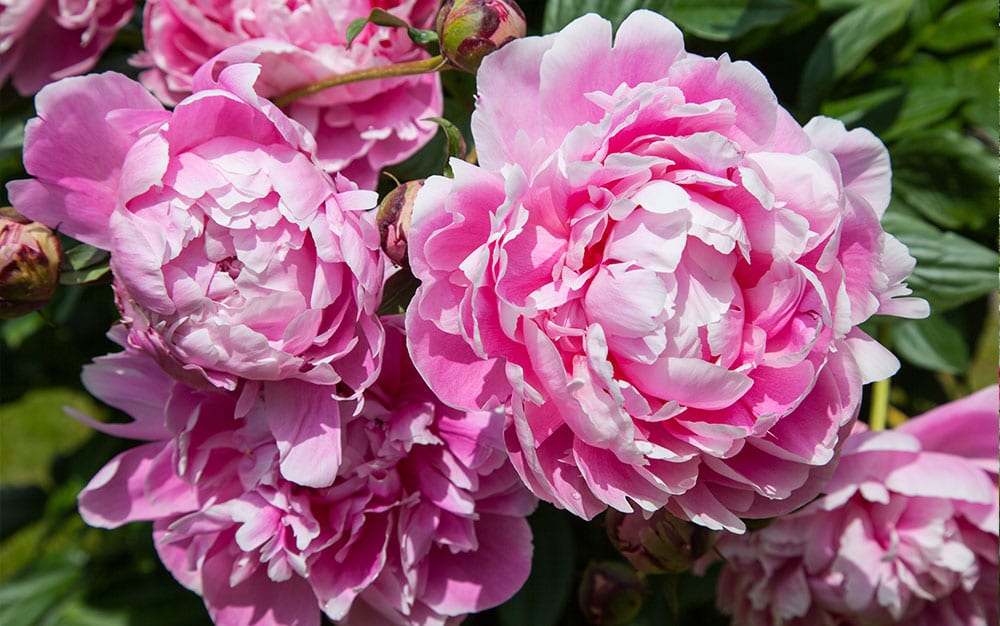
Peonies
Peonies, or paeonia, are a classic British garden plant, famous for their bold foliage and big, showy flowers. They look divine planted in borders, giving the garden a punch of colour and fragrance from mid-spring to mid-summer. They can also be used as a low hedge, or mixed with roses, irises and columbines for a full flower bed.
Division
Peonies can be divided into two groups: herbaceous perennials with soft growth that dies back over winter, and tree peonies with woody stems that do not.
The plants have large, alternate leaves that are often tinged with bronze when young and rich red in autumn. But the real showstoppers are the flowers. They can be single, double or anemone-form and have lightly ruffled edges. The outer petals are broad and striking, and the centre is filled with strong stamens. They also make fantastic cut flowers.
Brilliant white
P. lactiflora ‘Duchesse de Nemours’ is an old peony with white ruffled petals that deepen to yellow at the centre. It’s tall and has a strong, sweet fragrance. It’s also floriferous, meaning it grows multiple blooms on each stem that make excellent cut flowers.
Another good variety is P. lactiflora ‘Do Tell’, which has open, anemone-form petals and striking pink and white stamen. It won the American Peony Society Gold Medal in 2004, and grows prolifically in Britain. It has dark green foliage and strong red stems that won’t need staking.
Soft yellow

P. ‘Bartzella’ is an intersectional hybrid made from a cross between a white herbaceous peony and a yellow tree peony. It’s one of the most popular hybrids around, and won the American Peony Society Gold Medal in 2006. The huge blooms can be 25cm in diameter and have lemon yellow petals with red bases. It flowers prolifically without the need for staking, and has a lovely lemon fragrance.
How to grow peonies
Peonies are great for beginner or lazy gardeners, because they’re hardy and low-maintenance. They prefer full sun but tolerate light shade and thrive in most soil types.
Plant them in the autumn and once established they will look after themselves. They usually reach 60-90cm tall, but some varieties will get up to 150cm high.
The flower heads may need staking when in full bloom to stop the stems snapping. Cut the foliage as it dies back in autumn to avoid peony wilt – a grey mould.
Peonies are long-lived plants but they don’t like being transplanted, so leave them where they are. If you absolutely have to, move it in the autumn and try to create as little root disturbance as possible.
Did you know? Ants love peonies and can often be seen crawling over the buds and flowers. But don’t worry – they are there for the sweet nectar the flowers produce and don’t harm the plant!
Blushing pink
P. lactiflora Sarah Bernhardt is a long-time classic peony. It’s a floriferous variety named after the famous Victorian actress. The huge blooms have crinkled pink petals and a light fragrance. It’s a tall bush with rich green foliage that will need staking.
For something a bit more modern, try P. Coral Charm, a hybrid peony with salmon-coloured petals and a bright yellow centre. The blooms are in an antique rose form, and they fade from coral to a peach shade as the flower opens. The foliage stays green all year round, and it grows to 120cm tall.
Rich reds
P. lactiflora ‘Felix Crousse’ is an old, floriferous peony with a faint fragrance. It has rich raspberry-red flowers with a wide collar and a tightly packed centre. It’s a dependable variety with good drought resistance but may need staking.
Another good variety is P. suffruticosa ‘Rimpo’, a tree peony. It can grow up to 150cm tall, and has lovely deciduous foliage. It hails from Japan and has large blooms in a deep red shade with bright yellow stamen.

Leave A Comment